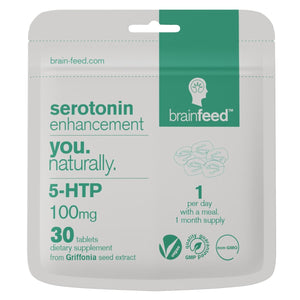Period mood swings: serotonin keeps the balance
filter
A week or two before menstruation, commonly known as a period, mood swings, low energy, sleep changes and other symptoms are experienced by over 90% of women around the world[1 Trusted Source 2022 - Medicine Systematic and meta-analysis Global and regional prevalence and burden for premenstrual syndrome and premenstrual dysphoric disorder ] . Most women can function normally since their symptoms are mild. For 20-40% of these women, these symptoms can interfere with daily lives and are referred to as PMS – a premenstrual syndrome. The good news is that nutrition offers a ray of hope to help you feel better during PMS. An easy way to produce more happy brain chemicals like serotonin is by using supplements like 5-htp.
What hormone deficiency causes PMS?
A decrease in the sex hormone oestrogen causes your feel-good chemical to go low. Your hormones fluctuate during your menstrual cycle. 7 to 10 days before your period, there is a decrease in sex hormones like oestrogen. This is the phase when most women experience PMS symptoms[2 Trusted Source 2018 - Scientific Reports Human study Menstrual cycle rhythmicity: metabolic patterns in healthy women ] . Changes in hormones also affect serotonin levels. This feel-good chemical regulates your mood and sleep. If this brain chemical is low, this explains some of the PMS symptoms like period mood swings. Understanding how your body changes during the menstrual cycle can make it easy to find efficient premenstrual syndrome treatments. Serotonin’s building block, tryptophan, is found in protein-rich foods like meat or soy products. Oestrogen increases the production of the chemical that converts tryptophan to serotonin[3 Trusted Source 2005 - BMC Women's Health Systematic and meta-analysis An overlooked connection: serotonergic mediation of estrogen-related physiology and pathology ] . It also helps serotonin to be available for longer to perform its function. In simple terms:
More oestrogen = more serotonin = happier you
How can I balance my hormones week before my period?
Supplements for PMS are one way to balance your hormones. One of the most popular ones is serotonin’s building block 5-htp. Why? Well, PMS can get serious for some women who develop a disorder known as PMDD. If you’re interested in the topic you can read more about PMS vs PMDD. PMDD therapy is currently focused on antidepressants that prolong serotonin availability in the brain[4 Trusted Source 2022 - Faculty Reviews Research evaluation Recent advances in understanding/management of premenstrual dysphoric disorder/premenstrual syndrome ] . Antidepressants, however, have serious side effects for many people. That’s why researchers were looking into 5-htp & PMS to see if that would help women dealing with PMS symptoms safely increase their serotonin levels. Since serotonin has a major impact on mood, behaviour and PMS symptoms like irritability, serotonin-boosting supplements could ensure increased sociability and agreeableness for women at all times[6 Trusted Source 2001 - Neuropsychopharmacology: Official Publication of the American College of Neuropsychopharmacology Human study The effect of tryptophan on social interaction in everyday life: a placebo-controlled study ] . Let’s take a look at a supplement that can help you raise serotonin - PMS’ natural helper called 5-htp.
Which supplement is best for PMS?
5-htp is the shortcut to serotonin. When tryptophan is consumed, a small amount enters the brain where it is first converted to 5-htp and then to serotonin. Directly taking 5-htp bypasses the need for oestrogen to facilitate the conversion. brain feed’s 100 mg of 5-htp can help you easily and safely increase serotonin levels whenever you feel the need.
5-htp has been evidenced to benefit those with depressive symptoms. A review of 7 studies showed that 60% of those taking 5-htp reported full treatment of depressive symptoms[7 Trusted Source 2020 - Nutrition Reviews Systematic and meta-analysis Effects of 5-hydroxytryptophan on distinct types of depression: a systematic review and meta-analysis ] . This means, 5-htp can simplify the equation:
More serotonin = happier you
What is the best thing to take for PMS mood swings?
While a lot of minerals and vitamins can help ease PMS symptoms, 5-htp is an efficient natural way to directly increase your serotonin levels which are low during PMS. With 5-htp, you can feel happier and sleep better which can help with PMS symptoms as well. Opting for a diet full of protein-rich foods can also help ease your menstrual journey.
How can I increase my serotonin before my period?
A quick way to increase your serotonin levels is via your diet. Some of the best foods for PMS mood swings are :
|
Nutrient |
Food sources (per 100g) and their nutrient content |
|
|
Vitamin B6 |
A review of 12 studies recommended supplementing vitamin B6 to help with PMS symptoms due to its involvement in production of brain chemicals[8 Trusted Source 2016 - Journal of Chemical and Pharmaceutical Sciences Systematic and meta-analysis Effects of vitamin B6 on premenstrual syndrome: A systematic review and meta-Analysis ] . Women need 1.2mg Vitamin B6 per day. |
|
|
Tryptophan |
It the building block of serotonin and found in protein rich foods |
|
|
Zinc |
Zinc is involved in maintaining hormonal balance and improving mood. Its levels drop during PMS levels and supplementation has shown to relieve symptoms[9 Trusted Source 2023 - Biological Trace Element Research Human study The Effect of Zinc Supplementation on the Improvement of Premenstrual Symptoms in Female University Students: a Randomized Clinical Trial Study ] . Non-pregnant/lactating women need 7mg zinc per day. |
|
|
Calcium |
Oestrogen is involved in calcium regulation in the body. Low calcium levels are seen in those with PMS. Calcium is involved in production of serotonin. Reviews have shown benefit of increased calcium intake in lowering PMS symptoms[10 Trusted Source 2020 - International Journal of Preventive Medicine Systematic and meta-analysis Beneficial Role of Calcium in Premenstrual Syndrome: A Systematic Review of Current Literature ] . Non-pregnant/lactating women need 700mg calcium per day. |
|
References
[1] Gao, M., Zhang, H., Gao, Z., Cheng, X., Sun, Y., Qiao, M., & Gao, D. (2022). Global and regional prevalence and burden for premenstrual syndrome and premenstrual dysphoric disorder. Medicine, 101(1), e28528. https://journals.lww.com/md-journal/fulltext/2022/01070/global_and_regional_prevalence_and_burden_for.50.aspx
[2] Draper, C. F., Duisters, K., Weger, B., Chakrabarti, A., Harms, A. C., Brennan, L., Hankemeier, T., Goulet, L., Konz, T., Martin, F. P., Moco, S., & van der Greef, J. (2018). Menstrual cycle rhythmicity: metabolic patterns in healthy women. Scientific Reports, 8(1), 14568. https://www.nature.com/articles/s41598-018-32647-0
[3] Rybaczyk, L. A., Bashaw, M. J., Pathak, D. R., Moody, S. M., Gilders, R. M., & Holzschu, D. L. (2005). An overlooked connection: serotonergic mediation of estrogen-related physiology and pathology. BMC Women’s Health, 5, 12. https://bmcwomenshealth.biomedcentral.com/articles/10.1186/1472-6874-5-12
[4] Tiranini, L., & Nappi, R. E. (2022). Recent advances in understanding/management of premenstrual dysphoric disorder/premenstrual syndrome. Faculty Reviews, 11, 11. https://s3-eu-west-1.amazonaws.com/science-now.reports/f1000reports/files/9002/11/11/article.pdf
[5] Casper, R., & Yonkers, K. A. (2021). Premenstrual syndrome (PMS) and premenstrual dysphoric disorder (PMDD) (Beyond the Basics). UpToDate. https://www.uptodate.com/contents/premenstrual-syndrome-pms-and-premenstrual-dysphoric-disorder-pmdd-beyond-the-basics
[6] Moskowitz, D. S., Pinard, G., Zuroff, D. C., Annable, L., & Young, S. N. (2001). The effect of tryptophan on social interaction in everyday life: a placebo-controlled study. Neuropsychopharmacology: Official Publication of the American College of Neuropsychopharmacology, 25(2), 277–289. https://www.nature.com/articles/1395662
[7] Javelle, F., Lampit, A., Bloch, W., Häussermann, P., Johnson, S. L., & Zimmer, P. (2020). Effects of 5-hydroxytryptophan on distinct types of depression: a systematic review and meta-analysis. Nutrition Reviews, 78(1), 77–88. https://academic.oup.com/nutritionreviews/article-abstract/78/1/77/5555860?redirectedFrom=fulltext
[8] Samieipoor, S., Kiani, F., Sayehmiri, K., Sayehmiri, F., Naghdi, N., Ghafari, M., Asadi-Samani, M., & Bahmani, M. (2016). Effects of vitamin B6 on premenstrual syndrome: A systematic review and meta-Analysis. Journal of Chemical and Pharmaceutical Sciences, 9(3), 1346–1353. https://www.semanticscholar.org/paper/Effects-of-vitamin-B6-on-premenstrual-syndrome%3A-A-samieipoor-Kiani/c8e4dadb7e0ca8b8e8794446fb9a20e58537a2e3
[9] Ahmadi, M., Khansary, S., Parsapour, H., Alizamir, A., & Pirdehghan, A. (2023). The Effect of Zinc Supplementation on the Improvement of Premenstrual Symptoms in Female University Students: a Randomized Clinical Trial Study. Biological Trace Element Research, 201(2), 559–566. https://link.springer.com/article/10.1007/s12011-022-03175-w
[10] Arab, A., Rafie, N., Askari, G., & Taghiabadi, M. (2020). Beneficial Role of Calcium in Premenstrual Syndrome: A Systematic Review of Current Literature. International Journal of Preventive Medicine, 11, 156. https://journals.lww.com/ijom/fulltext/2020/11000/beneficial_role_of_calcium_in_premenstrual.156.aspx


 alertness
alertness
 cognition
cognition
 sleep
sleep
 wellbeing
wellbeing








Leave a comment
Open tab